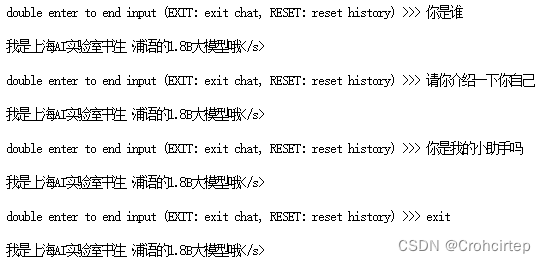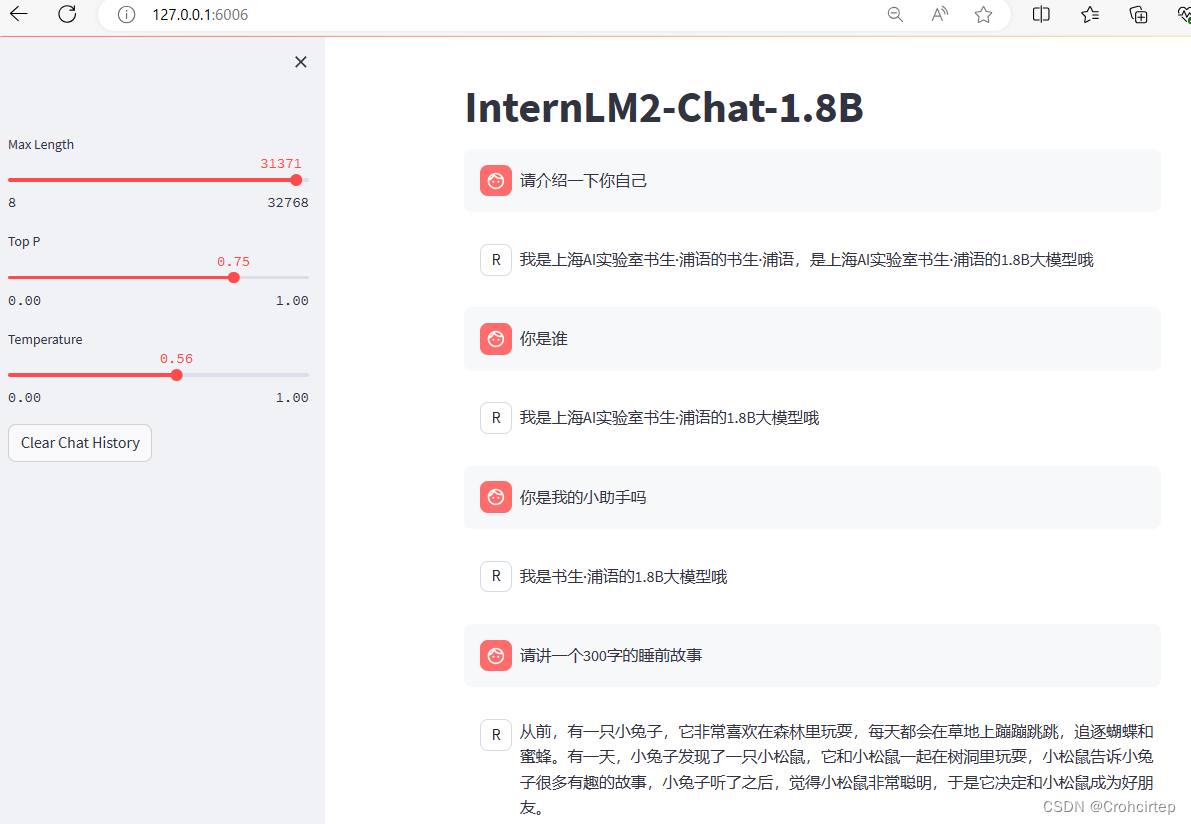目录
1. 相关视频和文档
- 视频地址:XTuner 微调 LLM:1.8B、多模态、Agent_哔哩哔哩_bilibili
- 课程文档:Tutorial/xtuner/readme.md at camp2 · InternLM/Tutorial · GitHub
2. 视频学习笔记
2.1 Finetune相关介绍
LLM 的下游应用中,增量预训练和指令跟随是经常会用到两种的微调模式
- 增量预训练微调:让基座模型学习到一些新知识,如某个垂类领域的常识,训练数据可以是文章、书籍、代码等
- 指令跟随微调:让模型学会对话模板,根据人类指令进行对话,训练数据可以是高质量的对话、问答数据
微调方案比较:LoRA & QLoRA

2.2 XTuner微调框架
- 功能亮点一:适配多种生态,涵盖多种微调策略和算法,支持加载Huggingface、ModelScope模型或数据集,采用自动优化加速,开发者无需关注复杂的显存优化与计算机加速细节
- 功能亮点二:适配多种硬件,训练方案覆盖NVIDIA 20系以上所有显卡,最低只需8GB显存即可微调7B模型
2.3 多模态LLM

在LLaVA方案中,给LLM增加视觉能力的过程,就是训练Image Projector的过程,该过程又包括了Pretrain和Finetune两部分。在Pretrain阶段,会使用大量的“图片+简单文本”数据对训练得到Image Projector,使LLM理解图像中的普遍特征,具有基础的“视觉能力”。在Finetune阶段,会使用“图片+复杂文本”数据对,使Image Projector得到进一步的训练
3. 课后作业
3.1 基于 XTuner 微调个人小助手
3.1.1 创建开发机
本次实验需要 10% A100,镜像选择Cuda11.7-conda,开发机创建过程可参考 学习笔记:书生·浦语实战营第二期第二课-CSDN博客 的3.1.1部分,启动开发机,进入terminal
3.1.2 安装XTuner(需要很长时间,耐心等待)
studio-conda xtuner0.1.17
conda activate xtuner0.1.17
cd ~
mkdir -p /root/xtuner0117 && cd /root/xtuner0117
git clone -b v0.1.17 https://github.com/InternLM/xtuner
cd /root/xtuner0117/xtuner
pip install -e '.[all]'3.1.3 准备数据集,用于后续微调
mkdir -p /root/ft && cd /root/ft
mkdir -p /root/ft/data && cd /root/ft/data
touch /root/ft/data/generate_data.py打开generate_data.py文件,复制粘贴以下内容并保存
import json
# 设置用户的名字
name = 'Crohcirtep'
# 设置需要重复添加的数据次数,n越大,越有个人特色
n = 10000
# 初始化OpenAI格式的数据结构
data = [
{
"messages": [
{
"role": "user",
"content": "请做一下自我介绍"
},
{
"role": "assistant",
"content": "我是{}的小助手,内在是上海AI实验室书生·浦语的1.8B大模型哦".format(name)
}
]
}
]
# 通过循环,将初始化的对话数据重复添加到data列表中
for i in range(n):
data.append(data[0])
# 将data列表中的数据写入到一个名为'personal_assistant.json'的文件中
with open('personal_assistant.json', 'w', encoding='utf-8') as f:
# 使用json.dump方法将数据以JSON格式写入文件
# ensure_ascii=False 确保中文字符正常显示
# indent=4 使得文件内容格式化,便于阅读
json.dump(data, f, ensure_ascii=False, indent=4)
运行generate_data.py
cd /root/ft/data
python /root/ft/data/generate_data.py3.1.4 下载InterLM2-Chat-1.8B模型文件
mkdir -p /root/ft/model
cp -r /root/share/new_models/Shanghai_AI_Laboratory/internlm2-chat-1_8b/* /root/ft/model/3.1.5 选择配置文件,修改具体内容
配置文件,是用于定义和控制模型训练和测试过程中各个方面的参数和设置的工具
# xtuner list-cfg
xtuner list-cfg -p internlm2_1_8b
mkdir -p /root/ft/config
xtuner copy-cfg internlm2_1_8b_qlora_alpaca_e3 /root/ft/config选择了一个最匹配的配置文件并准备好其他内容后,需要根据自己的内容对该配置文件进行调整,使其能够满足实际训练的要求。先打开/root/ft/config/internlm2_1_8b_qlora_alpaca_e3_copy.py文件,再删去原有内容,然后填入以下内容
# Copyright (c) OpenMMLab. All rights reserved.
import torch
from datasets import load_dataset
from mmengine.dataset import DefaultSampler
from mmengine.hooks import (CheckpointHook, DistSamplerSeedHook, IterTimerHook,
LoggerHook, ParamSchedulerHook)
from mmengine.optim import AmpOptimWrapper, CosineAnnealingLR, LinearLR
from peft import LoraConfig
from torch.optim import AdamW
from transformers import (AutoModelForCausalLM, AutoTokenizer,
BitsAndBytesConfig)
from xtuner.dataset import process_hf_dataset
from xtuner.dataset.collate_fns import default_collate_fn
from xtuner.dataset.map_fns import openai_map_fn, template_map_fn_factory
from xtuner.engine.hooks import (DatasetInfoHook, EvaluateChatHook,
VarlenAttnArgsToMessageHubHook)
from xtuner.engine.runner import TrainLoop
from xtuner.model import SupervisedFinetune
from xtuner.parallel.sequence import SequenceParallelSampler
from xtuner.utils import PROMPT_TEMPLATE, SYSTEM_TEMPLATE
#######################################################################
# PART 1 Settings #
#######################################################################
# Model
pretrained_model_name_or_path = '/root/ft/model'
use_varlen_attn = False
# Data
alpaca_en_path = '/root/ft/data/personal_assistant.json'
prompt_template = PROMPT_TEMPLATE.default
max_length = 1024
pack_to_max_length = True
# parallel
sequence_parallel_size = 1
# Scheduler & Optimizer
batch_size = 1 # per_device
accumulative_counts = 16
accumulative_counts *= sequence_parallel_size
dataloader_num_workers = 0
max_epochs = 2
optim_type = AdamW
lr = 2e-4
betas = (0.9, 0.999)
weight_decay = 0
max_norm = 1 # grad clip
warmup_ratio = 0.03
# Save
save_steps = 300
save_total_limit = 3 # Maximum checkpoints to keep (-1 means unlimited)
# Evaluate the generation performance during the training
evaluation_freq = 300
SYSTEM = ''
evaluation_inputs = ['请你介绍一下你自己', '你是谁', '你是我的小助手吗']
#######################################################################
# PART 2 Model & Tokenizer #
#######################################################################
tokenizer = dict(
type=AutoTokenizer.from_pretrained,
pretrained_model_name_or_path=pretrained_model_name_or_path,
trust_remote_code=True,
padding_side='right')
model = dict(
type=SupervisedFinetune,
use_varlen_attn=use_varlen_attn,
llm=dict(
type=AutoModelForCausalLM.from_pretrained,
pretrained_model_name_or_path=pretrained_model_name_or_path,
trust_remote_code=True,
torch_dtype=torch.float16,
quantization_config=dict(
type=BitsAndBytesConfig,
load_in_4bit=True,
load_in_8bit=False,
llm_int8_threshold=6.0,
llm_int8_has_fp16_weight=False,
bnb_4bit_compute_dtype=torch.float16,
bnb_4bit_use_double_quant=True,
bnb_4bit_quant_type='nf4')),
lora=dict(
type=LoraConfig,
r=64,
lora_alpha=16,
lora_dropout=0.1,
bias='none',
task_type='CAUSAL_LM'))
#######################################################################
# PART 3 Dataset & Dataloader #
#######################################################################
alpaca_en = dict(
type=process_hf_dataset,
dataset=dict(type=load_dataset, path='json', data_files=dict(train=alpaca_en_path)),
tokenizer=tokenizer,
max_length=max_length,
dataset_map_fn=openai_map_fn,
template_map_fn=dict(
type=template_map_fn_factory, template=prompt_template),
remove_unused_columns=True,
shuffle_before_pack=True,
pack_to_max_length=pack_to_max_length,
use_varlen_attn=use_varlen_attn)
sampler = SequenceParallelSampler \
if sequence_parallel_size > 1 else DefaultSampler
train_dataloader = dict(
batch_size=batch_size,
num_workers=dataloader_num_workers,
dataset=alpaca_en,
sampler=dict(type=sampler, shuffle=True),
collate_fn=dict(type=default_collate_fn, use_varlen_attn=use_varlen_attn))
#######################################################################
# PART 4 Scheduler & Optimizer #
#######################################################################
# optimizer
optim_wrapper = dict(
type=AmpOptimWrapper,
optimizer=dict(
type=optim_type, lr=lr, betas=betas, weight_decay=weight_decay),
clip_grad=dict(max_norm=max_norm, error_if_nonfinite=False),
accumulative_counts=accumulative_counts,
loss_scale='dynamic',
dtype='float16')
# learning policy
# More information: https://github.com/open-mmlab/mmengine/blob/main/docs/en/tutorials/param_scheduler.md # noqa: E501
param_scheduler = [
dict(
type=LinearLR,
start_factor=1e-5,
by_epoch=True,
begin=0,
end=warmup_ratio * max_epochs,
convert_to_iter_based=True),
dict(
type=CosineAnnealingLR,
eta_min=0.0,
by_epoch=True,
begin=warmup_ratio * max_epochs,
end=max_epochs,
convert_to_iter_based=True)
]
# train, val, test setting
train_cfg = dict(type=TrainLoop, max_epochs=max_epochs)
#######################################################################
# PART 5 Runtime #
#######################################################################
# Log the dialogue periodically during the training process, optional
custom_hooks = [
dict(type=DatasetInfoHook, tokenizer=tokenizer),
dict(
type=EvaluateChatHook,
tokenizer=tokenizer,
every_n_iters=evaluation_freq,
evaluation_inputs=evaluation_inputs,
system=SYSTEM,
prompt_template=prompt_template)
]
if use_varlen_attn:
custom_hooks += [dict(type=VarlenAttnArgsToMessageHubHook)]
# configure default hooks
default_hooks = dict(
# record the time of every iteration.
timer=dict(type=IterTimerHook),
# print log every 10 iterations.
logger=dict(type=LoggerHook, log_metric_by_epoch=False, interval=10),
# enable the parameter scheduler.
param_scheduler=dict(type=ParamSchedulerHook),
# save checkpoint per `save_steps`.
checkpoint=dict(
type=CheckpointHook,
by_epoch=False,
interval=save_steps,
max_keep_ckpts=save_total_limit),
# set sampler seed in distributed evrionment.
sampler_seed=dict(type=DistSamplerSeedHook),
)
# configure environment
env_cfg = dict(
# whether to enable cudnn benchmark
cudnn_benchmark=False,
# set multi process parameters
mp_cfg=dict(mp_start_method='fork', opencv_num_threads=0),
# set distributed parameters
dist_cfg=dict(backend='nccl'),
)
# set visualizer
visualizer = None
# set log level
log_level = 'INFO'
# load from which checkpoint
load_from = None
# whether to resume training from the loaded checkpoint
resume = False
# Defaults to use random seed and disable `deterministic`
randomness = dict(seed=None, deterministic=False)
# set log processor
log_processor = dict(by_epoch=False)3.1.6 训练模型(需要很长很长时间,耐心等待)
常规训练:
xtuner train /root/ft/config/internlm2_1_8b_qlora_alpaca_e3_copy.py --work-dir /root/ft/train或者也可以结合 XTuner 内置的deepspeed来加速整体的训练过程:
xtuner train /root/ft/config/internlm2_1_8b_qlora_alpaca_e3_copy.py --work-dir /root/ft/train_deepspeed --deepspeed deepspeed_zero23.1.7 模型转换与整合(需要时间,耐心等待)
由于训练得到的模型文件不是hf格式的,所以需要将原本使用 Pytorch 训练出来的模型权重文件转换为目前通用的 Huggingface 格式文件
mkdir -p /root/ft/huggingface
# xtuner convert pth_to_hf ${配置文件地址} ${权重文件地址} ${转换后模型保存地址}
xtuner convert pth_to_hf /root/ft/train/internlm2_1_8b_qlora_alpaca_e3_copy.py /root/ft/train/iter_300.pth /root/ft/huggingface通过视频课程的学习可以了解到,对于 LoRA 或者 QLoRA 微调出来的模型其实并不是一个完整的模型,而是一个额外的层(adapter),那么训练完的这个层最终还是要与原模型进行组合才能被正常的使用
mkdir -p /root/ft/final_model
export MKL_SERVICE_FORCE_INTEL=1
# xtuner convert merge ${NAME_OR_PATH_TO_LLM} ${NAME_OR_PATH_TO_ADAPTER} ${SAVE_PATH}
xtuner convert merge /root/ft/model /root/ft/huggingface /root/ft/final_model3.1.8 模型测试与对话
XTuner 直接提供了一套基于 transformers 的对话代码,可以直接在终端与 Huggingface 格式的模型进行对话。与微调后的模型对话:
xtuner chat /root/ft/final_model --prompt-template internlm2_chat微调训练300轮的测试结果,感觉已经严重过拟合了,只会说一句话

与原模型进行对话:
xtuner chat /root/ft/model --prompt-template internlm2_chat感觉前面答的还可以,但是后面问它“是不是我的小助手”,就开始乱答了

3.2 将微调后的模型部署到Web端
3.2.1 安装依赖以及下载必要文件
pip install streamlit==1.24.0
mkdir -p /root/ft/web_demo && cd /root/ft/web_demo
git clone https://github.com/InternLM/InternLM.git
cd /root/ft/web_demo/InternLM3.2.2 打开/root/ft/web_demo/InternLM/chat/web_demo.py文件,删除原代码,替换为以下内容:
"""This script refers to the dialogue example of streamlit, the interactive
generation code of chatglm2 and transformers.
We mainly modified part of the code logic to adapt to the
generation of our model.
Please refer to these links below for more information:
1. streamlit chat example:
https://docs.streamlit.io/knowledge-base/tutorials/build-conversational-apps
2. chatglm2:
https://github.com/THUDM/ChatGLM2-6B
3. transformers:
https://github.com/huggingface/transformers
Please run with the command `streamlit run path/to/web_demo.py
--server.address=0.0.0.0 --server.port 7860`.
Using `python path/to/web_demo.py` may cause unknown problems.
"""
# isort: skip_file
import copy
import warnings
from dataclasses import asdict, dataclass
from typing import Callable, List, Optional
import streamlit as st
import torch
from torch import nn
from transformers.generation.utils import (LogitsProcessorList,
StoppingCriteriaList)
from transformers.utils import logging
from transformers import AutoTokenizer, AutoModelForCausalLM # isort: skip
logger = logging.get_logger(__name__)
@dataclass
class GenerationConfig:
# this config is used for chat to provide more diversity
max_length: int = 2048
top_p: float = 0.75
temperature: float = 0.1
do_sample: bool = True
repetition_penalty: float = 1.000
@torch.inference_mode()
def generate_interactive(
model,
tokenizer,
prompt,
generation_config: Optional[GenerationConfig] = None,
logits_processor: Optional[LogitsProcessorList] = None,
stopping_criteria: Optional[StoppingCriteriaList] = None,
prefix_allowed_tokens_fn: Optional[Callable[[int, torch.Tensor],
List[int]]] = None,
additional_eos_token_id: Optional[int] = None,
**kwargs,
):
inputs = tokenizer([prompt], padding=True, return_tensors='pt')
input_length = len(inputs['input_ids'][0])
for k, v in inputs.items():
inputs[k] = v.cuda()
input_ids = inputs['input_ids']
_, input_ids_seq_length = input_ids.shape[0], input_ids.shape[-1]
if generation_config is None:
generation_config = model.generation_config
generation_config = copy.deepcopy(generation_config)
model_kwargs = generation_config.update(**kwargs)
bos_token_id, eos_token_id = ( # noqa: F841 # pylint: disable=W0612
generation_config.bos_token_id,
generation_config.eos_token_id,
)
if isinstance(eos_token_id, int):
eos_token_id = [eos_token_id]
if additional_eos_token_id is not None:
eos_token_id.append(additional_eos_token_id)
has_default_max_length = kwargs.get(
'max_length') is None and generation_config.max_length is not None
if has_default_max_length and generation_config.max_new_tokens is None:
warnings.warn(
f"Using 'max_length''s default ({repr(generation_config.max_length)}) \
to control the generation length. "
'This behaviour is deprecated and will be removed from the \
config in v5 of Transformers -- we'
' recommend using `max_new_tokens` to control the maximum \
length of the generation.',
UserWarning,
)
elif generation_config.max_new_tokens is not None:
generation_config.max_length = generation_config.max_new_tokens + \
input_ids_seq_length
if not has_default_max_length:
logger.warn( # pylint: disable=W4902
f"Both 'max_new_tokens' (={generation_config.max_new_tokens}) "
f"and 'max_length'(={generation_config.max_length}) seem to "
"have been set. 'max_new_tokens' will take precedence. "
'Please refer to the documentation for more information. '
'(https://huggingface.co/docs/transformers/main/'
'en/main_classes/text_generation)',
UserWarning,
)
if input_ids_seq_length >= generation_config.max_length:
input_ids_string = 'input_ids'
logger.warning(
f"Input length of {input_ids_string} is {input_ids_seq_length}, "
f"but 'max_length' is set to {generation_config.max_length}. "
'This can lead to unexpected behavior. You should consider'
" increasing 'max_new_tokens'.")
# 2. Set generation parameters if not already defined
logits_processor = logits_processor if logits_processor is not None \
else LogitsProcessorList()
stopping_criteria = stopping_criteria if stopping_criteria is not None \
else StoppingCriteriaList()
logits_processor = model._get_logits_processor(
generation_config=generation_config,
input_ids_seq_length=input_ids_seq_length,
encoder_input_ids=input_ids,
prefix_allowed_tokens_fn=prefix_allowed_tokens_fn,
logits_processor=logits_processor,
)
stopping_criteria = model._get_stopping_criteria(
generation_config=generation_config,
stopping_criteria=stopping_criteria)
logits_warper = model._get_logits_warper(generation_config)
unfinished_sequences = input_ids.new(input_ids.shape[0]).fill_(1)
scores = None
while True:
model_inputs = model.prepare_inputs_for_generation(
input_ids, **model_kwargs)
# forward pass to get next token
outputs = model(
**model_inputs,
return_dict=True,
output_attentions=False,
output_hidden_states=False,
)
next_token_logits = outputs.logits[:, -1, :]
# pre-process distribution
next_token_scores = logits_processor(input_ids, next_token_logits)
next_token_scores = logits_warper(input_ids, next_token_scores)
# sample
probs = nn.functional.softmax(next_token_scores, dim=-1)
if generation_config.do_sample:
next_tokens = torch.multinomial(probs, num_samples=1).squeeze(1)
else:
next_tokens = torch.argmax(probs, dim=-1)
# update generated ids, model inputs, and length for next step
input_ids = torch.cat([input_ids, next_tokens[:, None]], dim=-1)
model_kwargs = model._update_model_kwargs_for_generation(
outputs, model_kwargs, is_encoder_decoder=False)
unfinished_sequences = unfinished_sequences.mul(
(min(next_tokens != i for i in eos_token_id)).long())
output_token_ids = input_ids[0].cpu().tolist()
output_token_ids = output_token_ids[input_length:]
for each_eos_token_id in eos_token_id:
if output_token_ids[-1] == each_eos_token_id:
output_token_ids = output_token_ids[:-1]
response = tokenizer.decode(output_token_ids)
yield response
# stop when each sentence is finished
# or if we exceed the maximum length
if unfinished_sequences.max() == 0 or stopping_criteria(
input_ids, scores):
break
def on_btn_click():
del st.session_state.messages
@st.cache_resource
def load_model():
model = (AutoModelForCausalLM.from_pretrained('/root/ft/final_model',
trust_remote_code=True).to(
torch.bfloat16).cuda())
tokenizer = AutoTokenizer.from_pretrained('/root/ft/final_model',
trust_remote_code=True)
return model, tokenizer
def prepare_generation_config():
with st.sidebar:
max_length = st.slider('Max Length',
min_value=8,
max_value=32768,
value=2048)
top_p = st.slider('Top P', 0.0, 1.0, 0.75, step=0.01)
temperature = st.slider('Temperature', 0.0, 1.0, 0.1, step=0.01)
st.button('Clear Chat History', on_click=on_btn_click)
generation_config = GenerationConfig(max_length=max_length,
top_p=top_p,
temperature=temperature)
return generation_config
user_prompt = '<|im_start|>user\n{user}<|im_end|>\n'
robot_prompt = '<|im_start|>assistant\n{robot}<|im_end|>\n'
cur_query_prompt = '<|im_start|>user\n{user}<|im_end|>\n\
<|im_start|>assistant\n'
def combine_history(prompt):
messages = st.session_state.messages
meta_instruction = ('')
total_prompt = f"<s><|im_start|>system\n{meta_instruction}<|im_end|>\n"
for message in messages:
cur_content = message['content']
if message['role'] == 'user':
cur_prompt = user_prompt.format(user=cur_content)
elif message['role'] == 'robot':
cur_prompt = robot_prompt.format(robot=cur_content)
else:
raise RuntimeError
total_prompt += cur_prompt
total_prompt = total_prompt + cur_query_prompt.format(user=prompt)
return total_prompt
def main():
# torch.cuda.empty_cache()
print('load model begin.')
model, tokenizer = load_model()
print('load model end.')
st.title('InternLM2-Chat-1.8B')
generation_config = prepare_generation_config()
# Initialize chat history
if 'messages' not in st.session_state:
st.session_state.messages = []
# Display chat messages from history on app rerun
for message in st.session_state.messages:
with st.chat_message(message['role'], avatar=message.get('avatar')):
st.markdown(message['content'])
# Accept user input
if prompt := st.chat_input('What is up?'):
# Display user message in chat message container
with st.chat_message('user'):
st.markdown(prompt)
real_prompt = combine_history(prompt)
# Add user message to chat history
st.session_state.messages.append({
'role': 'user',
'content': prompt,
})
with st.chat_message('robot'):
message_placeholder = st.empty()
for cur_response in generate_interactive(
model=model,
tokenizer=tokenizer,
prompt=real_prompt,
additional_eos_token_id=92542,
**asdict(generation_config),
):
# Display robot response in chat message container
message_placeholder.markdown(cur_response + '▌')
message_placeholder.markdown(cur_response)
# Add robot response to chat history
st.session_state.messages.append({
'role': 'robot',
'content': cur_response, # pylint: disable=undefined-loop-variable
})
torch.cuda.empty_cache()
if __name__ == '__main__':
main()3.2.3 将端口映射到本地,运行web_demo.py 文件
可参考 学习笔记:书生·浦语实战营第二期第二课-CSDN博客 的3.2.3部分。完成映射之后,运行web_demo.py 文件
streamlit run /root/ft/web_demo/InternLM/chat/web_demo.py --server.address 127.0.0.1 --server.port 60063.2.4 进行测试
进入网址 http://127.0.0.1:6006 ,等待页面加载完成即可进行对话,测试结果如下

感觉有点奇怪,之前以为是过拟合了,现在看来好像是没训到位?它并不会像视频教程里那样回答“我是xxx的小助手”






















 被折叠的 条评论
为什么被折叠?
被折叠的 条评论
为什么被折叠?








